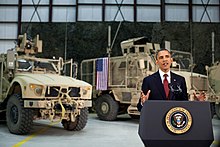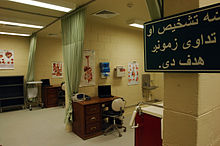Bagram Airfield
Sitting on the site of the ancient town of Bagram at an elevation of 1,492 metres (4,895 ft) above sea level, the air base has two concrete runways.During the 1980s Soviet–Afghan War, it played a key role, serving as a hub for the Limited Contingent of Soviet Forces in Afghanistan operations and a base for its troops and supplies.Aircraft based at Bagram, including the 368th Assault Aviation Regiment flying Su-25s, provided close air support for Soviet and Afghan troops in the field.Taliban forces were consistently within artillery and mortar range of the field, denying full possession of the strategic facility to the Northern Alliance.Press reports indicated that at times a Northern Alliance general was using the bombed-out control tower as an observation post and as a location to brief journalists, with his headquarters nearby.During the US-led retribution on the Taliban for harboring the terrorist organization responsible for 9/11, the base was secured by a team from the United Kingdom's Special Boat Service.Troops and civilians had various dining options that included Pizza Hut, Subway, an Afghan restaurant, as well as Green Beans coffee shops.The wooden structures had no concrete foundation and thus were not considered permanent housing, just an upgrade from the tents, the only option Bagram personnel and troops had seen previously.This new runway is 497 metres (1,631 ft) longer than the previous one and 280 millimetres (11 in) thicker, giving it the ability to land larger aircraft, such as the C-5 Galaxy, C-17 Globemaster III, Il-76, An-124, An-225 or the Boeing 747 (which is used by civilian cargo airlines).[3] The 2007 Bagram Airfield bombing was a suicide attack that killed up to 23 people and injured 20 more, at a time when Dick Cheney, then Vice-President of the United States, was visiting Afghanistan.This claim is supported by the relatively limited number of large suicide bombings carried out in Afghanistan, combined with the intensity of this particular attack, and the fact that Cheney was at the base.One of the rockets landed next to a B-Hut in a camp located on the west side of the base killing a Bosnian national, who was working at Bagram as a contract firefighter.[43] On 9 March 2024, National Resistance Front of Afghanistan (NRF) fighters claimed responsibility for an attack which killed the Bagram Division's chief of staff.[45] Camp Vance, Afghanistan[46] was the base, 1.4 km from the airfield, established in December 2002 by the United States Department of Defense to headquarter the Combined Joint Special Operations Task Force (CJSOTF).[47] The camp was named for Gene Arden Vance Jr., a member of the U.S. Special Forces and a cryptologic linguist who, despite being critically wounded, helped save the lives of two fellow Americans and 18 Afghan soldiers during the hunt for Osama bin Laden in the War in Afghanistan.[51] Apart from military and intelligence personnel, the only people officially allowed inside the prison building were Red Cross representatives who inspected the facility once every two weeks.[50] However, some interrogators routinely administered harsh treatment which included alleged beatings, sleep deprivation, sexual humiliation, shackling to ceilings, and threats with guard dogs.The film details the severe beatings and torture, and ultimate death, of an Afghan taxi driver being held at the Parwan Detention Facility.







F-16 Fighting FalconMinistry of DefenseAfghan Armed ForcesBagramCoordinatesRunwaysConcreteCharikarParwan ProvinceAfghanistanAfghan Ministry of Defensesea levelair baseLockheed Martin C-5 GalaxyrevetmentsU.S. military base455th Air Expeditionary WingU.S. Air ForceKabul International AirportTalibanAfghan National ArmyParwan Detention FacilityInternational Committee of the Red Crosssecond prisonAfghanistan–United States relationsAfghan Air ForceEisenhowerSoviet UnionCold WarFidel CastroAfghan Prime MinisterDaud KhanU.S. PresidentDwight EisenhowerZahir ShahSoviet–Afghan WarLimited Contingent of Soviet Forces in AfghanistanSoviet Airborne TroopsdivisionsSu-25sSovietMiG-21108th Motor Rifle Division345th Independent Guards Airborne RegimentWestern-funded and Pakistani-trainedmujahideenSoviet Armed ForcesoccupationNorthern AllianceartillerymortarFROG-72019 Bagram Airfield attackDonald RumsfeldUS-led retribution on the Taliban for harboring the terrorist organization responsible for 9/11Special Boat Service10th Mountain DivisionMacDill Air Force Base82nd Airborne DivisionFort Bragg11th Signal BrigadeFort Huachuca40 CommandoRoyal MarinesPizza HutSubwayKandahar International AirportLandminesB-hutsUnited States Army RangerPat TillmanGeorge W. BushLaura BushAir Force OneC-5 GalaxyC-17 Globemaster IIIAn-124An-225Boeing 7472007 Bagram Airfield bombingsuicide attackDick CheneyVice-President of the United StatesYousef AhmadiOsama bin LadenSouth Korean soldierVeterans Daymaterial witnessesThe StateCharlestonforcesBarack Obama2012 Afghanistan Quran burning protestsAfghan National Security ForcesThanksgivingDonald TrumpUS withdrawal from AfghanistanNational Resistance Front of AfghanistanVictory against the United States and Western powersGene Arden Vance Jr.War in Afghanistancounterinsurgencytorture and prisoner abuseThe New York TimesAmnesty InternationalRed Crosssleep deprivationsexual humiliationGuantanamo BayTaxi to the Dark SideUnited States Armyred poppy flowersDanish Air Forceleft at least 23 people deadCH-47 ChinookUnited Arab Emirates Air ForceC-130 HerculesP-3 OrionNaval Air Station BrunswickACT AirlinesAirbus A300French ArmyGazelle VivianeNational Airlines Flight 102killed 6 U.S. troopsmanaged to enter the Air Force base

